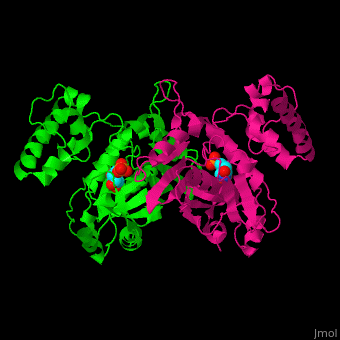Thymidylate synthase
From Proteopedia
(Difference between revisions)
| Line 8: | Line 8: | ||
== Relevance == | == Relevance == | ||
TS inhibition at its folate-binding site is used in anticancer therapeutic drugs. DHFR-TS inhibitors are potential drug targets against parasite-transferred diseases. TS exhibits oncogene-like activity.<ref>PMID:15093541</ref> | TS inhibition at its folate-binding site is used in anticancer therapeutic drugs. DHFR-TS inhibitors are potential drug targets against parasite-transferred diseases. TS exhibits oncogene-like activity.<ref>PMID:15093541</ref> | ||
| + | |||
| + | Due to its role in cell division, thymidylate synthase has become a popular target for anticancer drugs. Indirect inhibition of thymidylate synthase by the drug 5-fluorouracil (5-FU) is one of the most used inhibitors for study of TS function. This drug indirectly inhibits TS as it it eventually converted to FdUMP, which forms a covalent complex with both the active site cysteine and CH<sub>2</sub>H<sub>4</sub>F. Inhibition of TS halts the production of dTMP and, indirectly, 2'-deoxythymidine-5'-triphosphate (dTTP). Both dTMP and dTTP are essential building blocks for DNA synthesis and their absence halts the ability of cells to replicate their genetic information. This is especially effective in cancer cells that rapidly divide and require large amounts of dTMP and dTTP. <ref>DOI 10.2174/0929867054864868</ref> | ||
== Structural highlights == | == Structural highlights == | ||
Revision as of 15:14, 13 April 2022
Thymidylate Synthase (TS) is an important enzyme in one-carbon metabolism[1]. TS catalyzes the transfer of a methyl group and a hydride from 5,10-methylenetetrahydrofolate to 2-deoxyuridine-5'-monophosphate, resulting in the formation of thymidine 5'-monophosphate and dihydrofolate. This is the only de novo source of dTMP (a precursor to Thymine) in humans. [1]
2-deoxyuridine-5'-monophosphate(dUMP) + 5, 10-methylenetetrahydrofolate(CH2H4F) ⇌ thymidine 5'-monophosphate(dTMP) + Dihydrofolate(H2F)
| |||||||||||
References
- ↑ Kholodar SA, Finer-Moore JS, Swiderek K, Arafet K, Moliner V, Stroud RM, Kohen A. Caught in Action: X-ray Structure of Thymidylate Synthase with Noncovalent Intermediate Analog. Biochemistry. 2021 Apr 8. doi: 10.1021/acs.biochem.1c00063. PMID:33829766 doi:http://dx.doi.org/10.1021/acs.biochem.1c00063
- ↑ Kaneda S, Nalbantoglu J, Takeishi K, Shimizu K, Gotoh O, Seno T, Ayusawa D. Structural and functional analysis of the human thymidylate synthase gene. J Biol Chem. 1990 Nov 25;265(33):20277-84. PMID:2243092
- ↑ Rahman L, Voeller D, Rahman M, Lipkowitz S, Allegra C, Barrett JC, Kaye FJ, Zajac-Kaye M. Thymidylate synthase as an oncogene: a novel role for an essential DNA synthesis enzyme. Cancer Cell. 2004 Apr;5(4):341-51. PMID:15093541
- ↑ Costi MP, Ferrari S, Venturelli A, Calo S, Tondi D, Barlocco D. Thymidylate synthase structure, function and implication in drug discovery. Curr Med Chem. 2005;12(19):2241-58. doi: 10.2174/0929867054864868. PMID:16178783 doi:http://dx.doi.org/10.2174/0929867054864868
- ↑ Finer-Moore JS, Fauman EB, Morse RJ, Santi DV, Stroud RM. Contribution of a salt bridge to binding affinity and dUMP orientation to catalytic rate: mutation of a substrate-binding arginine in thymidylate synthase. Protein Eng. 1996 Jan;9(1):69-75. PMID:9053905
Proteopedia Page Contributors and Editors (what is this?)
Michael O'Shaughnessy, Karsten Theis, Michal Harel, Alexander Berchansky, Shaylie Albright, Anna Postnikova, Kia Yang, Joel L. Sussman

